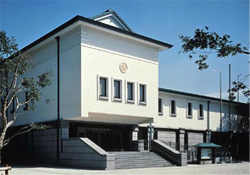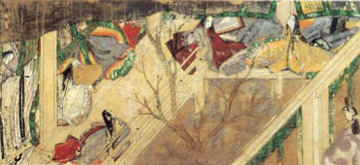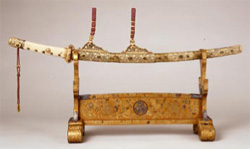Home > Highlighting JAPAN > Highlighting Japan APRIL 2012 > Tokugawa Art Museum
Highlighting JAPAN
THE NATION’S MUSEUMS
Tokugawa Art Museum
Housing the collected treasures of the Owari branch of the Tokugawa family, the Tokugawa Art Museum in Nagoya, Aichi Prefecture, offers an unrivalled window onto the life of the rich and powerful in Edo-period Japan. Julian Ryall took a look inside.

Tokugawa Art Museum in Nagoya, Aichi Prefecture
Credit: COURTESY OF TOKUGAWA ART MUSEUM
The Tokugawa Art Museum, in the heart of Nagoya and historical home of the Owari Tokugawa family, does a remarkable job of balancing the elements of what it meant to be a feudal lord in the years of Japan’s warrior states. Here on display alongside flawless swords that date back to the thirteenth century are Chinese-inspired utensils for the tea ceremony; there are matchlock rifles bearing the Tokugawa family crest and masks from the noh theater and there are helmets and standards from the battlefield.
The collection—of some 10,000 pieces in all—is particularly important, according to Curator Tomio Koike, because all other shogun families and daimyo (feudal lords) across Japan have been forced by their changed circumstances to sell off items that it had taken them generations to acquire.
“The Owari Tokugawa family ruled this province and held Nagoya Castle from the seventeenth to nineteenth centuries,” says Koike. “The family is now in its twenty-second generation.”

The twelfth-century “Handscroll of The Tale of Genji” ranks as a masterpiece in Japanese art and is a National Treasure.
Credit: COURTESY OF TOKUGAWA ART MUSEUM
The works of art, furnishings, armor, clothing and countless other items that had been used on a daily basis by the founder of the shogunate, Tokugawa Ieyasu, still form the core of the collection today.
The museum holds nine items that have been designated by the government as National Treasures, including the twelfth-century “Handscroll of the Tale of Genji,” as well as fifty-nine objects designated as Important Cultural Properties and forty-six works that are protected as Important Art Objects.
The museum is divided into a number of exhibition rooms, with the items on display changing every four weeks, Koike says.
Visitors initially enter the room displaying items from which the samurai class earned their reputation. As well as gracefully curved sword blades and an immaculate set of body armor, including helmet and mask, the warriors’ tools on display include bows and arrows and pikes.

A lacquered scabbard decorated with gold, mother-of-pearl and precious stones, formerly owned by Tokugawa Yoshinao, first Lord of Owari
Credit: COURTESY OF TOKUGAWA ART MUSEUM
The swords also incorporated smaller daggers which were used to open letters or nick a thumb so that a document could be signed in blood, but the hilt of the weapon was shaped so that it could be used to clean the warrior’s ears out.
It is an indication of the importance the samurai placed on their public appearances.
The second room includes a recreation of the Sarumen Tea House that stood alongside Nagoya Castle and where the daimyo would himself prepare and serve tea to his distinguished guests. As well as preparing the ceremonial drink, the feudal lord would have prepared the flower arrangement, further demonstrating his artistic sensibilities.
The museum includes a formal chamber from a daimyo’s residence, including a triptych of hanging scrolls with a strong Chinese influence in the art work, paintings that use a lot of gold and are of Confucian designs, and an alcove equipped with writing implements to underline the lord’s scholarly activities.
Subsequent rooms are given over to masks and kimono used in noh theater performances. Koike says the utmost care is taken of the kimono as the silk is very fragile. Many are complete with paperwork that shows when they were made and the occasion they were commissioned for.
What makes all the collections here truly outstanding is the attention to detail that has gone into making the objects and the love and commitment required to maintain their condition to this day.
| Access and Admission | |
| Address: | Tokugawa-cho, Higashi Ward, Nagoya 461-0023 |
| Tel/Fax: | +81 52 935 6262/+81 52 935 6261 |
| E-mail: | info [at] tokugawa.or.jp |
| Website: | http://www.tokugawa-art-museum.jp/english/index.html |
© 2009 Cabinet Office, Government of Japan






